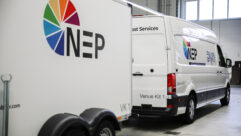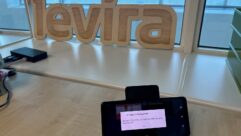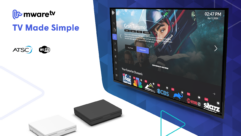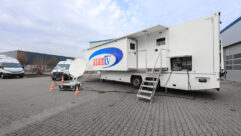
Local Public Broadcast TV Updates Remote Capabilities, Part 1
Mar 12, 2012 11:09 AM,
With Bennett Liles
Listen to the Podcasts
Editor’s note: For your convenience, this transcription of the podcast includes timestamps. If you are listening to the podcast and reading its accompanying transcription, you can use the timestamps to jump to any part of the audio podcast by simply dragging the slider on the podcast to the time indicated in the transcription.

The community cable TV stations cover a huge variety of local events that fly under the radar of most commercial stations, and that’s been the case with California’s Riverside Government TV. They recently got a huge boost in their production capability with a new remote van and Scott Brosious is here to give us the technical lowdown on it, coming right up on the SVC Podcast. SVC: Scott Brosious, thanks for being with us on the SVC Podcast from California’s Riverside Government TV, and I love those stations, Scott. Tell me a little about Riverside Government TV. What sort of programming do they have?
Riverside Government TV is a PEG channel. We operate here in Riverside, Calif. We do everything from government meetings to cooking shows to news to sporting events—a lot of different things. Most of what we do is city programs and services, and we want to tell people about things the city is doing—new road construction, new bridges; the city recently is coming to an end of a $1.5 billion renaissance addition where we rebuild hundreds of miles of roads and big bridges and new libraries, new community centers, new parks. So a lot of that in the last couple of years has been telling people about these things with the channel. We’ve recently starting doing sports and all that—live sports with the local UC (University of California) system and some of the school districts, football games, and things like that. We do cooking shows, we do a gardening show, we do healthy living kind of things, we do activities where we show people different things to do in town that they might not know are here. Things like rock climbing gyms we have here—lawn bowling. Things like that, things that most people aren’t going to know that are even here unless somebody tells them. [Timestamp: 2:02]
Right, you’re super local. And you mentioned that it’s a PEG channel; PEG for public, education and government, so explain to our listeners what a PEG channel is.
Yeah, PEG channel is basically a local channel that’s really only carried on the cable systems, public education and government like you said. Here at Riverside, we are GTV, is what we call it; it is the government channel. We run all the city government meetings, council meetings we do live. We also help the county. The county doesn’t have a channel like ours, but we take their meetings and send it over fiber from their location to us and then we play that on our channel because our channel isn’t just in the city; it covers the outlying county areas around us as well; so people that are not necessarily in the city but they’re pretty close; so they’re governed by the county; so we still play those county meetings too so that people that still get our channel have a way to be engaged with their local government. The people that make decisions that affect them. And at Riverside. we don’t have a public access for the P in PEG. We used to; it was handled by the cable companies, but with some legislation that has happened here in California, a lot of those public access channels have gone away and that is the case here. We do have, however, three education channels. We have four colleges and universities in Riverside, so we have three different education channels. One is run by the Riverside County Office of Education; they focus more on K-12. We have one at our community college. They have three campuses in the Riverside area; one directly in Riverside, so it’s ran out of the city college, which is Riverside Community College. They do distance learning and stuff like that. They have an active TV program there. That’s actually where I went to school, where I learned all this. And they play there; the students produce new shows, weekly new shows, magazine shows, and different films and things; they play all that there on their education channel. They also do a lot of arts programmings and things like that, and then the UC Riverside College campus has another PEG channel, another education channel, where they play a lot from the UC TV system, and they also intersperse it with some locally produced things that go on on campus at our local UC. [Timestamp: 4:12]

And one of the big developments there lately has been the new remote van. What was the production situation at GTV before and why did you need the new van?
Prior to us acquiring the van, we really had a very antiquated system. We had a couple of JVC cameras and some Canon cameras that we would go out and do a magazine show or more of a entertainment show, and it would take us weeks and weeks and weeks to get them done. We had two cameras or three cameras out there doing things. You would have to come back, back before we turned this into JVC; we were using all tape cameras, so you go out with 6-7 hours of tape; you got to come back and import that for 6-7 hours, so things took a long time to get done just because of our limited staff. Importing 7 hours of footage, that’s an entire day. So it kind of monopolized your time by having to sit here and import all these tapes. Back when I started here, we weren’t that old; we’ve only been around actively producing this channel for about six or seven years. Prior to when I started here, it was literally a SCALA broadcast system and digital signage system running a bulletin board and literally a VCR, VHS VCR, to record the meetings on and play them back off of half inch VHS tape. So over the years we’ve turned this into an all-digital system. We use JVC cameras to ingest or shoot everything and we have SD cards, so it’s all digital. We edit on Final Cut Pro. We output to a Leightronix playback system, so it’s all digital. So everything’s digital now. [Timestamp: 5:45]
Now, where did you get the van and who sort of help you in outfitting it and installing the right gear in it?
We purchased the van through Frontline Communications. It actually went through our local dealership. The city has a local preference purchasing program where the Fritts Ford here in Riverside purchased the van through Frontline and so Frontline built it, but Fritts Ford was the customer—kind of a subcontractor for it; so they were the ones we actually bought it from a local Ford dealership who then bought it from Frontline; so they outfitted it just like they would any other van. It’s the same van you see Channel 7 Eye Witness News or any other news van driving around in southern California. This close to L.A. there [are] news vans everywhere. And we have pretty much the exact same thing as them. It is a satellite system, so we do have a satellite mounted on it; but there’s no difference between what we have and what the guys in L.A. have. Rich Rosensweig of Vidiflo has helped me a lot with a lot of the city systems when we’ve been outfitting new control room for the city council chambers and adding the equipment; so together with Rich and I we configured the system and figured out what we would need and for what we want to do, which is mostly built it for sports because that is the biggest, the hardest, most difficult thing that this van can do is sports, so we geared it towards that and everything else, it can handle without a problem; sports is the most challenging thing it does. [Timestamp: 7:03]
Well, sports remotes will really grind you into the ground.
Oh, yeah.
So why did you decide to go with the JVC GY-HM790U Pro HD cameras?
We went with the 790s because we had some experience with the 700s when they first came out. We were trying to cut down the workflows and get rid of all those tapes and things; so we went with the 700 and we really liked that the quality of the picture is great, the ease of the workflow with the SD cards, which is the same on the 790—same picture quality, same SD cards. The 790 just keeps the flexibility to not only use it—you can use it as a EEG camera if you’re going out to do a quick news segment or you can use it in the truck for a football game. So the amount of things you can do with it and not have to have a studio camera and a separate ENG camera that was a big deal and the ease of use for them. We used to have to run an audio cable, a mic line for the intercom, a video cable; if you want a return video, you had to run that. You used to have to run six to seven cables per camera with 790 and the CopperHead units that you put on the backs; it’s one fiber cable—light, easy, flexible cable and you’re done. Power and everything is over this one cable and it’s a cinch to set up. [Timestamp: 8:15]

Yeah, that’s really something. The CopperHead Pro HD, I think it’s the KFF 790 fiber-optic transceivers that you got with that?
Yes, they are great and they can go, I remember, on the analog cable, you’re going to do a couple hundred feet, tops. The cables we bought, we only go in half the distance; we have 700-foot cables, which are more than we will ever need to get anywhere maybe other than the parade. But you can go up to 1600ft. with these cables; so you could see huge distances from where your camera guys are if you had to, if the situation called for it; you could be close to half a mile from your actual camera man if you had to be, and the power and like I said everything goes over that one cable, so you don’t need to patch into anything else or run any extra cables or do anything extra. One cable, 1,600ft., and you’re good to go. [Timestamp: 9:03]
And you’ve got power and video returns and intercom and everything over those.
Yeah, audio too, so we’ve used it a lot for if we wanted to do an announcer or one of our commentators on the field interviewing a coach before, you would either have to use a wireless mic, which the distances on a football field, on a lower end, wireless you might not get that signal that far. So you can either spend a lot of money on a nice high-end wireless or we can just patch the audio into the camera. It sends two channels. I think you can actually send four channels of audio over that as well, so we can just patch—any cameraman can just come up with the announcer with the coach, plug into his camera, push the feed up on the mixer, and now you have audio from directly from that camera so you can be anywhere on the field and just plug a mic in and you’re good to go as well. [Timestamp: 9:47]
Who mans all of this stuff? Who do you have for crew people and recording people? Is it part-time or full-time or a mix of the two?
Here at the city, me and my boss are the only two full-time employees. We also have two part timers who are here 20 to 30 hours a week, and we have maybe 15 to 20 contractors that we use; they’re really used for just the football games and the sporting events. So they work on an hourly basis. They’re subcontractors, so they come in; we schedule them out and then we have, I think it takes eight people to run the van when we have four cameras, so it works out well though. We get surprisingly a lot of programming out of the small crew we have, and I think a large part of that is because of the workflows we’ve created; we’ve made the systems so that they’re fast and efficient; you don’t have a lot of waste of time; you can just crank programming out as fast as you can go. [Timestamp: 10:36]
So how have things gone so far on the sports events? Any changes to the production routine and the equipment or anything because I would imagine that you’re pretty maxed out when you do sports events.
Yeah, it started out like everything new and so we had a little bit of kinks. We were crunched for time, so we started the football season; we did the last three weeks of the season for the high school football season; we did five games. So we had two teams, two weeks, and one game the other week, so it was a little hectic, but we were even still putting the van together. We were wiring up headsets as we were wiring up the stadium for that first football game, so it was hectic, and like everything, it’s a little bit of a learning curve. Most camera operators in the PEG world aren’t used to this high end of equipment so it took them a little while to get used to. I don’t have all this extra stuff I’ve got to carry and they loved it. They were happy that all they got was one cable. Super easy, super—everything’s great. They don’t have to run power cables or change out batteries in the middle of the game or all that kind of stuff that we used to have to do so it’s really great now; it’s like everyone loves it. [Timestamp: 11:38]
Well, that’s great now that you’ve got the routine down and any equipment kinks ironed out and people trained and all you got to do is go out there and roll and do the stuff. I really thank you for being here with us, Scott. In part 2 we’ll get into the satellite transmission and the Broadcast Pix Granite 500 switcher and some other things that you’ve got on the van, but we’ll see you then.
Thanks for having me.










